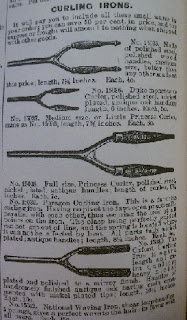We had lots of great guesses for our latest mystery artifact, including a fantastic guess working out exactly how it could be used as a prototype for a modern glue gun! However, penny6612 was exactly right when she guessed it was the heater for a curling iron. While it might not have worked well for the enormously long curling iron we had as mystery artifact last week, it would be just right for this later design:
As you can see in this add from the 1895 Montgomery Ward catalogue, there were several different types of curling iron heaters available on the market in the late 19th-century (although as the quote from Little Town on the Prairie showed last week, one could always heat curlers on the stove in a pinch!)
I find the descriptions of these heater fascinating, especially the multiple uses of the Peerless Lamp Chimney Stove ("To heat curling iron use as shown on this cut. To heat cup of water, remove loose top and all the heat of the lamp will come in direct contact with bottom of cup"). I also find the claims that both items can be folded and closed so each might be "carried in the pocket" quite intriguing; was on-the-go hair curling and styling a real need in the 1890s?
We hope you are enjoying the weekly mystery artifact posts. We are certainly having fun trying to stump our co-workers by finding artifacts with functions that are quite a challenge to guess! Make sure to check back over the next few days as our illustrious Director will be choosing the next mystery artifact!



















